Click on images to enlarge
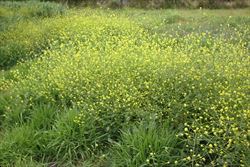
infestation (Photo: Sheldon Navie)
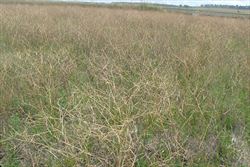
large infestation of old plants in summer (Photo: Sheldon Navie)

habit (Photo: Sheldon Navie)
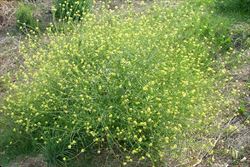
habit (Photo: Sheldon Navie)
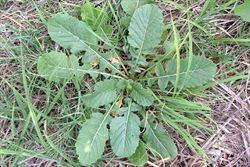
rosette of large lower leaves with deeply lobed bases (Photo: Sheldon Navie)
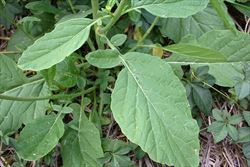
less-lobed leaves on the lower parts of the stems (Photo: Sheldon Navie)
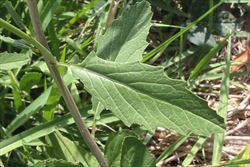
close-up of stem and smaller upper leaves with toothed margins (Photo: Sheldon Navie)
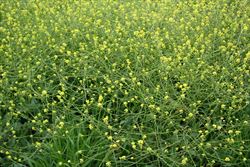
large branched and elongated flower clusters (Photo: Sheldon Navie)

close-up of yellow flowers (Photo: Sheldon Navie)
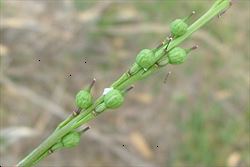
close-up of immature fruit with narrow bases, rounded upper parts and beaked tips (Photo: Sheldon Navie)

mature fruit (Photo: Sheldon Navie)
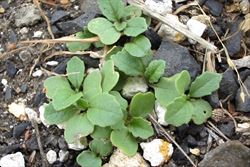
seedlings (Photo: Sheldon Navie)
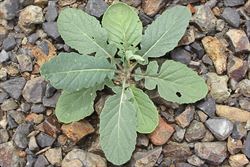
young plant (Photo: Sheldon Navie)
Scientific Name
Rapistrum rugosum (L.) All.
Synonyms
Myagrum rugosum L.Rapistrum rugosum (L.) All. subsp. rugosum
Family
Brassicaceae (Queensland, New South Wales, the ACT, Victoria, Tasmania, Western Australia and the Northern Territory).Cruciferae (South Australia)
Common Names
annual bastard cabbage, annual bastard-cabbage, annual bastardcabbage, bastard cabbage, common giant mustard, giant mustard, short fruited wild turnip, short-fruited wild turnip, turnip weed, turnip-weed, turnipweed, wild rape, wild turnip, wrinkled gold-of-pleasure
Origin
Native to southern European (i.e. France, Portugal, Spain, Albania, Bulgaria, Greece, Italy, Yugoslavia, Ukraine and southern Russia), the Azores, the Madeira Islands, the Canary Islands, northern Africa (i.e. northern Algeria, Egypt, northern Libya, Morocco and Tunisia) and western Asia.
Naturalised Distribution
A very widespread introduced species that is naturalised throughout large parts of Australia. It is most common in the southern and eastern parts of the country (i.e. it is widespread in Queensland, New South Wales, Victoria, Tasmania and South Australia and becoming more common in the south-western and southern parts of Western Australia). Also occasionally naturalised in the southern parts of the Northern Territory, sparingly naturalised in the ACT and naturalised on Norfolk Island.
Notes
Turnip weed (Rapistrum rugosum) is a very common weed of crops, orchards, vineyards, disturbed sites, waste areas, roadsides, urban bushland, waterways and pastures. Though it is mainly a weed of agricultural areas and habitation, turnip weed (Rapistrum rugosum) also invades natural vegetation. It is listed as a priority environmental weed in at least one Natural Resource Management region.
Turnip weed (Rapistrum rugosum) is invasive in intact native vegetation and has a moderate potential to reduce native species diversity. Once it has invaded an area it will persist and may develop dense stands, but it can be controlled with sustained effort. It develops a broad mass of basal leaves during the early stages of growth, which allows it to successfully out-compete native plant species.
It is a common weed in coastal habitats in the Gulf St. Vincent area in South Australia and has also been recorded in numerous conservation areas in this state (e.g. in Marino Conservation Park, Cobbler Creek Recreation Park, Mount Remarkable National Park, Black Hill Conservation Park, Belair National Park and Onkaparinga River National Park). Turnip weed (Rapistrum rugosum) is also regarded as an environmental weed in the Goulburn Broken Catchment in inland Victoria and is classified as a high impact weed species in grasslands in the LaTrobe Valley in the Gippsland Plain bioregion. It has been recorded growing in conservation areas in New South Wales (i.e. Kinchega National Park and Kwiambal National Park). In Western Australia, it is found in several places in the wheatbelt region and also appears to be spreading in the Dongara region. It is often found growing in wasteland or in disturbed natural vegetation, such as in fire breaks and urban bushland.
In the USA, where turnip weed (Rapistrum rugosum) is also mainly a weed of agricultural areas, it is becoming invasive in natural areas such as open forests and along waterways. As in Australia, it has sometimes been observed to form dense stands (i.e. monocultures) in such habitats.

